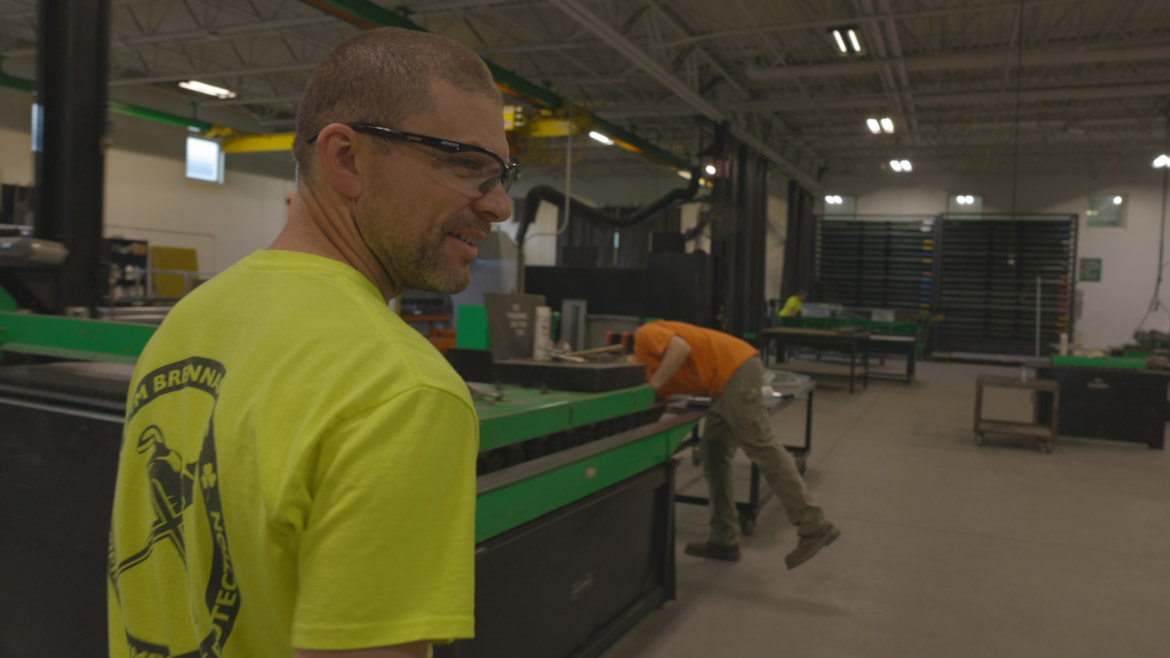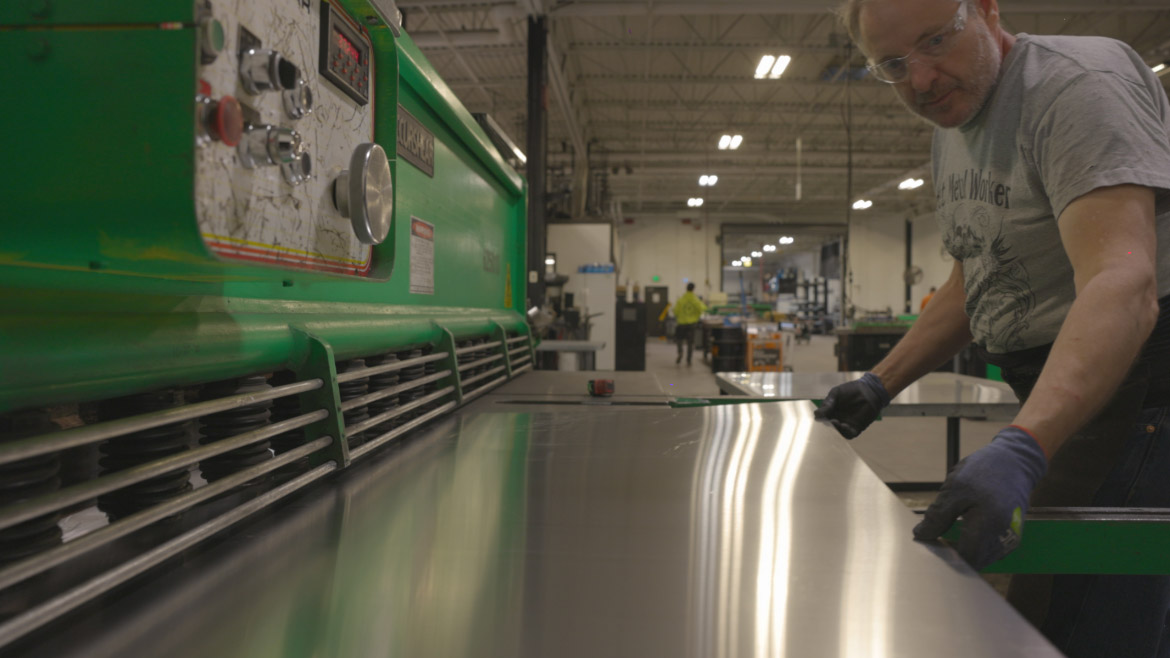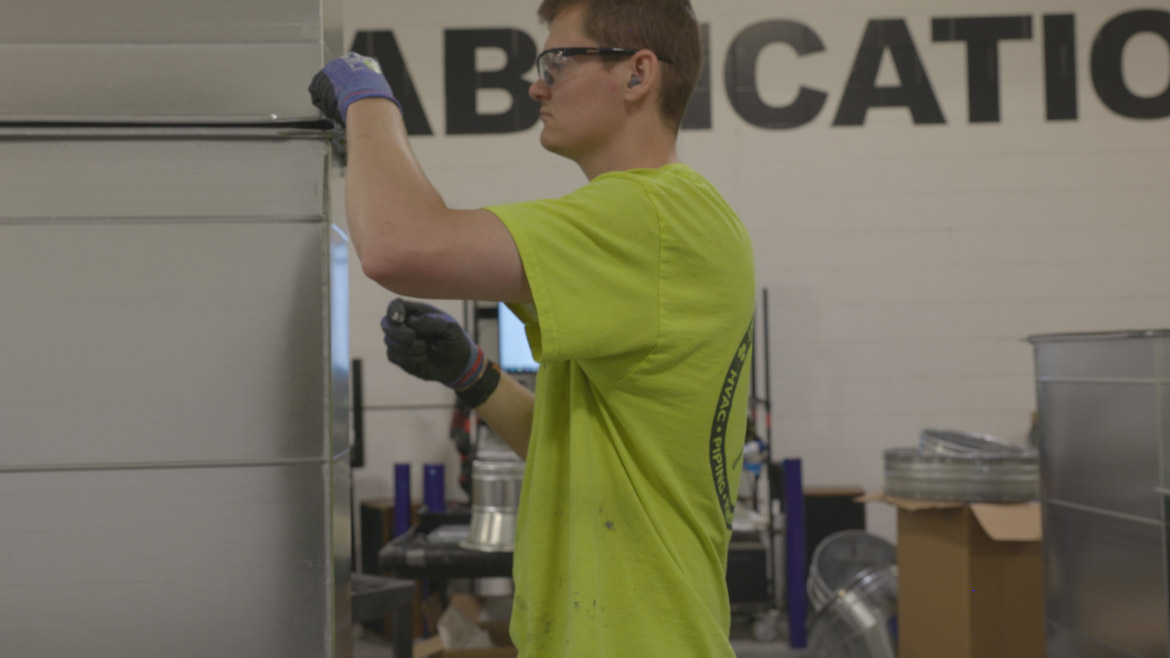In the late 1990s, J.M. Brennan, Inc. only had three fabrication workers and less than 12 field installers. However, as a sign of the Milwaukee, Wisconsin-based mechanical contractor’s steady growth, it now has more than 12 full-time fabrication employees that serve over 100 field installers.
At the same time, the mechanical contractor has expanded its sheet metal and miscellaneous metal fabrication operations considerably, too—from roughly 3,000 square feet to nearly 24,000 square feet.
This substantial growth is related to several primary goals. First, J.M. Brennan is cutting and forming thicker materials than it previously did. Second, it is conducting more specialty fabrication projects, such as catwalks, stairs and enclosures.
“We’ve also added spiral fabrication to our original rectangular ductwork,” said Justin Harer, director of construction operations at J.M. Brennan. “And we’ve added automation, such as coil line for straight ducts and a water jet for insulation liner cutting.”
Due to these various additions, the mechanical contractor is continuously increasing its revenue sources, while expanding its reach to other markets as well, which it previously couldn’t serve successfully.
“We saw opportunities for growth and worked towards being able to capitalize on those opportunities the last few years,” Harer stressed. “Additionally, we made strategic advances in capacities and tooling to take advantage of opportunities in other market sectors, while also acquiring more capacity to handle larger projects.”
A member of the mechanical contracting industry since 2002, Harer began to directly work on expanding J.M. Brennan’s sheet metal and metal fabrication operations and capabilities in 2010. Without question, the transformation didn’t occur overnight. Instead, it transpired over a few years, leading to many lessons learned and, in turn, advice for other professionals in the industry.

SPECIALIZED: The company’s investment in advanced sheet metal fabrication capabilities has allowed J.M. Brennan to take on more specialized projects, including thicker materials and custom architectural elements like catwalks and stairs.
Focus on Specialties First
While reflecting on the past 15 years and the results of his initiatives (for example, a significant rise in J.M. Brennan’s sheet metal workforce, from less than 10 to over 100), Harer recommends veteran operational leaders to focus on their specialties, first and foremost.
“As they prepare to expand their sheet metal operations, seasoned veterans must focus on the markets they understand first,” he emphasized. “They should continue to do what they do extremely well and efficiently.”
From there, he advises them to then expand their companies’ capacities as needed. By focusing on key specialties first, they’ll be able to bid on projects more competitively. Ultimately, they’ll also acquire project awards at higher margins than they likely would have otherwise.
Upon earning these project awards, veteran leaders can expand their operations further, enabling them to focus on additional opportunities for growth, whether they’re related to their primary specialties or not.
“Veterans should focus on what they do the majority of the time and make those processes as efficient as possible,” he added. “There will always be exceptions, but they shouldn’t let them determine their approaches to expansion.”
Harer believes that—by focusing on what they do the most often (at least 75% of their time)—veteran leaders will increase their sheet metal operations’ productivity in the most effective way possible.
“It’s okay if smaller exceptions take more time to develop and enhance,” he said. “After all, smaller exceptions aren’t leaders’ bread and butter anyways.”
Moreover, Harer recommends leaders to focus on the logistics of their sheet metal operations’ expansions, rather than just fabrication aspects.
“How are they going to get their finished products to their customers?” he asked. “Veterans must make this efficient as well.”

DUCTWORK: J.M. Brennan has transformed its operations to include both rectangular ductwork and spiral fabrication, supported by automation technology that enhances efficiency and precision.
The More Insights and Input, the Better
It’s important to remember that new mechanical contracting industry leaders can have a vital impact on sheet metal and metal fabrication operations, too. In fact, due to their novel ideas, they may expand and enhance operations in ways that veterans might not have even considered.
Nonetheless, Harer thinks newcomers should have veterans alongside them—experienced individuals who will help them effectively setup and run sheet metal and metal fabrication operations.
“Their insights are invaluable,” Harer noted. “Newcomers must be able to take feedback from veteran leaders.”
Open-mindedness is also crucial. Regardless of their experience levels, leaders may have to change their approaches (and be willing to do so), especially if their original ideas aren’t leading to the results they originally anticipated.

TRANSFORM: J.M. Brennan’s success story exemplifies how strategic growth, employee empowerment, and investment in modern fabrication technology can transform a mechanical contracting business.
“By being able to pivot—even midstream while implementing something because it isn’t working—leaders will save valuable time and money in the long run,” Harer stated. “They must listen to the team members that are doing the work too, as they’ll have some fantastic ideas on how they can make their roles more productive.”
The bottom line? Mechanical contracting industry leaders should acquire input from every single stakeholder that’s involved with their sheet metal and metal fabrication operations, particularly those who are working on shop floors.
“Their perspectives can be priceless, as the best ideas often come from the employees that are doing the work,” Harer said.
Experimentation is highly impactful as well. Harer believes leaders should provide employees as many opportunities to experiment as possible.
“They should make it okay for them to fail,” he added. “Failing, while trying something new, isn’t a failure, as long as everyone that’s involved learns from it.”
Finally, Harer can’t stress the importance of employee treatment enough. Perhaps seasoned veterans or newcomers want to expand their operations’ square footage by 500 or 5,000 square feet. Or they’re striving to increase their workforce by 10 or 1,000. No matter what their goals are, leaders won’t notice long-term success if they don’t focus on improving their employees’ work lives.
“Sheet metal and metal fabrication operation leaders have to listen to their employees and show them respect,” he concluded. “They must be taken care of, as they’re the greatest resources by far — and it’s not even close!”

